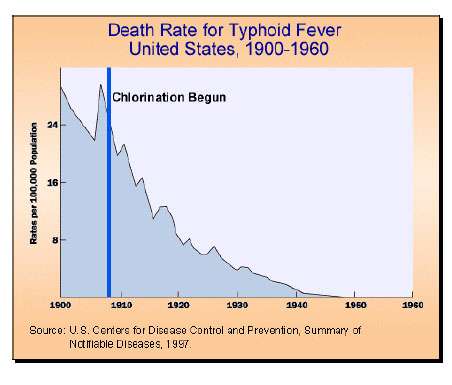Electrochlorination
Electrochlorination is the process of producing hypochlorite by running an electric current through salt water. This is used to disinfect water and make it safe for human use, such as for drinking water or swimming pools.
Process
The processes involved in electrochlorination are actually rather simple. The main idea involved is the electrolysis of water to produce a chlorinated solution. This happens when saltwater is inserted into electrolyzer cells. The first step is removing the solid excess from the saltwater. Next, as the saltwater runs it is streamed through a channel of decreasing thickness. One side of the channel is a cathode, the other is an anode. As the water flows through the anode/cathode channel, a low voltage DC current's applied. When this happens, the electrolysis is triggered and sodium hypochlorite is instantly produced as well as hydrogen gas (H2). The hydrogen rich sodium hypochlorite then travels to a tank that removes the hydrogen gas. The dehydrogenization mechanism varies from device to device but the process is generally the same. After hydrogen has been removed from the solution, it is stored in a tank as the finished product.[1] No chemicals other than ordinary salt, or sodium chloride (NaCl), are used throughout the entirety of the process. Although the actual chemical processes involved are complex, they can be simply represented by the following equation:
NaCl + H2O + ENERGY → NaOCl + H2
In words this reads: energy is added to sodium chloride (table salt) in water, resulting in sodium hypochlorite and hydrogen gas.
Seawater
On occasion, companies will want to use seawater for this process due to its extreme low obtaining cost. The seawater used is usually brackish water or brine (i.e. a solution with >0.5% salinity). In these cases, random chemicals may be introduced into the system. These random chemicals pose no threat to the system however, due to the simplicity of the process. The low voltage DC current that is applied will do only what it is intended to do, i.e. electrochlorination. The excess random chemicals are left untouched and can be easily discarded.[2]
Products
The product of this process, sodium hypochlorite, contains 0.7% to 1% chlorine. Anything below the concentration of 1% chlorine is considered a non-hazardous chemical although still a very effective disinfectant. In addition, the sodium hypochlorite produced is in the pH range of 6-7.5. This means that the chemical is relatively neutral in regards to acidity or baseness. Also, at that pH range, the sodium hypochlorite is extremely stable and the electrochlorination extremely effective.[3]
Applications
Drinking Water
Local water treatment plants have begun to evolve their technology over the years as health threats due to water contamination become more known including cholera, typhoid, and dysentery. to combat these threats, water treatment plants began to implement chlorination. Chlorination virtually wiped out both the spread and initial contamination of these diseases, and did so in a way that earned it the title of "the most significant public health advance of the millennium” from Life Magazine.[4][3]

Electrochlorination is the next step in the evolution of this process. Electrochlorination chlorinates drinking water and does so in an Eco-friendly way. It does not harm the environment in any measurable negative way. Unlike other chlorination techniques, electrochlorination generates no sludge or by-products. It also is safer for the operators of the chlorinators as there is no handling of chlorine gas, which is highly toxic and corrosive.[3]
Swimming Pools
When a swimmer enters a pool, they add up to one billion organisms to the water. Chlorination kills all organisms harmful to swimmers such as those that cause ear infections and athlete's foot. The advantages of electrochlorination in this process are as follows:[3]
- Not irritating to skin or soft tissue.
- Active in small concentrations.
- Longer lifespan of chemical and therefore the less replacement necessary.
- Easily measurable.
Electrochlorination chlorinates water in an Eco-friendly manner. Unlike other chlorination techniques, electrochlorination generates no sludge or by-products. It also is safer for the operators of the chlorinators as there is no handling of chlorine gas, which is highly toxic and corrosive.[3]
References
- ↑ Electrochlorination System incorrect link
- ↑ Water Engineers
- 1 2 3 4 5 Encee Chlorination
- ↑ ["Chlorination." Life Magazine. Web. Life Magazine]